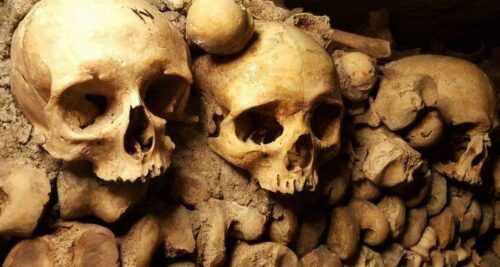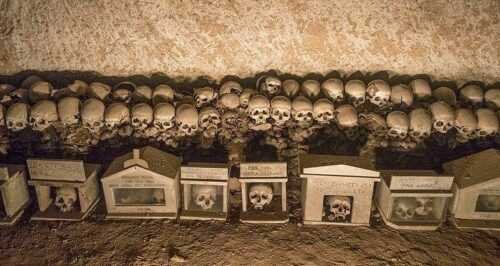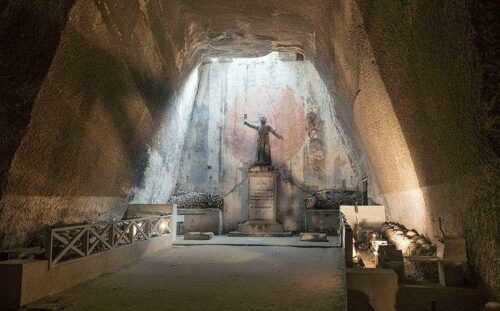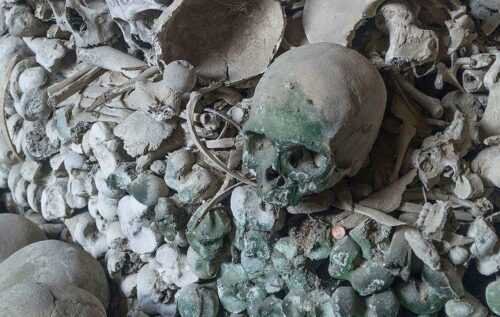
Like the catacombs of Paris, Europe houses several ossuaries; one of them being Fontanelle Cemetery in Naples– a secondary burial ground, well, more like a cave, I’d say.
It came into being when the churchyards and graveyards started flooding with dead bodies.
However, unlike other catacombs, the skulls of the dead were cared for lovingly, despite knowing nothing about the dead person’s history- they were given names- asked for predictions of winning lottery numbers.
History of Fontanelle Cemetery
The unloading of the dead bodies within the Fontanelle cave temporarily started during the Spanish occupation of Naples in the 1500s.
However, the reason why the city was inundated into a sea of dead bodies due to the eruption of a devastating plague in 1650, followed by smaller cholera that plagued the city in the 1930s.
The plague of 1656 arrived in January and swept off half of the population of Naples by August. It was estimated that about 150,000 lives were taken by this deadly epidemic. The city took a long time to recover from the incident.
And those who died from the such tragedy were buried and lobbed into a cave in the most disorganized situations. What’s worse- some of them were buried without the last rituals- almost everyone is without any headstone.

According to the tradition of the highly catholic population, these souls were locked in the form of anguish. Nobody dared to go near the Underground Cemetery Naples, Italy, due to its haunted atmosphere.
They only went at times of placing the bodies during the plague. There was a time when the catacomb became so congested with slapdash-loaded bones & bodies that once, during heavy rainfall, the whole city was flooded by a wave of skulls and bones.
Father Gaetano Barbati started the giant assignment of collecting and organizing these bodies & bones. They were properly organized and placed on shelves and racks, in tombs or boxes- though they remained unburied.
As they sorted the bodies, the volunteers would pray for the dead- give names to them, as well, by the women who look after them, and who’d frequently return to talk with or ask for help from the dead. They placed papers wherein their wishes were written and rolled them into the eye sockets.
This ‘cult’ continued until the bombings of world war II as Naples was the center of bombings during the war in Italy. Fontanelle and other underground places in the city aided as a bomb shelter.
The Fontanelle cemetery is a concoction of natural caves, ancient Roman and Greek tunnels, and tufa mines. Under the sleuth of Vesuvius, Naples is located in the Campi Flegrei.

Image Credit: Fontanelle cemetery
It was a spot of intense volcanic activity that left the space-separated with thermal springs and caves. The Greek inhabitants of the region sculpted and excavated the soft volcanic stone and used some of the space as their personal burial ground.
The Romans followed the tunnels and canals through the hills that were interlinked with the natural cave systems.
Fontanelle Cemetery Naples Italy
After the war, the cult for the dead reached its height in Fontanelle, with women attaching themselves to the dead, taking care of the skulls and bones, bringing them flowers, talking to them, and asking for favors.
Several skulls were claimed and put in wooden slots by individuals as their personal lucky charms or source of prophecies.
The Fontanelle cemetery became a well-known make-out spot and the late hangout spot for those experimenting with black magic.
In an endeavor to purify the place, a small church was built called Maria Santissima Del Carmine, close to the cave’s opening. However, it was mostly ignored.
All these crazy fashion cults stopped when the Cardinal of Naples condemned them. He commanded the closing of the Fontanelle cemetery in 1969.
This ended the agitating skull obsession. After Fontanelle Cemetery closed for several years, the reservation opened again.

Image Credit: Fontanelle Cemetery
Naples Underground
Beneath the Fontanelle city of Naples rests a great geothermal zone comprised of tuff- volcanic rock. Over the last 2 and a half eras, vast caves and tunnels have been whittled out of the volcanic rocks, creating a dark city concealed underneath the ground.
The 450km underground network was concocted by the Greeks in the 4th century BCE to build a new city, which they knew as ‘Neapolis.’
The Romans subsequently used the chambers and conduits to build canals that offered water for several centuries for Neapolitans.
As time passed, buildings were constructed on top of the former infrastructures. The remains of these buildings are veiled deep underneath the city.
Today, Naples Underground (Napoli Sotterranea) proffers an opportunity to discover the city of Italy from a different perspective.
Canals, cesspool tunnels, caves, graveyards, and pre-Christian hypogea could be found along rail tunnels and roadways. Certain caves that were part of the lake are still filled with water today.
After several years, the subterranean network was used as a shelter during WWII. You could still view the forgotten war remnants, such as war vehicles & weapons, in the tunnels.
Recently, it was revealed that here-the world’s first hypogeum garden, could be found. Research to grow diverse species of plants far-off from pollution. However, light, as well- in the dark cavity beneath the city.

Image Credit: Fontanelle Cemetery
Some tunnels are very confined, and it is required to utilize a candle to see. Preceding 2010, the fontanelle cemetery opened only a few days yearly for the public.
However, it is open year-round. Tourists could freely wander through the site without having to have a guide.
Fontanelle Cemetery Tickets
You won’t have to pay for the Fontanelle cemetery tickets price, as entry is free. Though beware of the cons, if you decide to visit the Fontanelle cemetery, you don’t have to pay any ticket price.
Timetables of Fontanelle Cemetery
Here you will get Fontanelle cemetery opening times: The Fontanelle cemetery of Naples is open every day from Monday to Sunday. And it opens from 10.00 AM- 5.00 PM. You can also read Easter Island.
FAQs
After a collapse at the Chapel of the Resurrection in a Naples cemetery on January 5, around 300 graves were destroyed. As a result, the Naples Prosecutor’s Office ordered the cemetery’s closure and is currently investigating 20 people for their potential involvement in causing the accident during metro construction work.
The Chapel of the Resurrection is a four-story building used for funerals, and it has compartments for coffins and urns. However, some of these compartments were destroyed in the incident, and several graves were destroyed because the building partially collapsed.
Read Also:







Sweet blog! I found it while searching on Yahoo News.
Do you have any tips on how to get listed in Yahoo News?
I’ve been trying for a while but I never seem to get there!
Cheers
Thanks for your compliment.
And sorry, here I am sharing about travel, travel experience and other travel-related information.